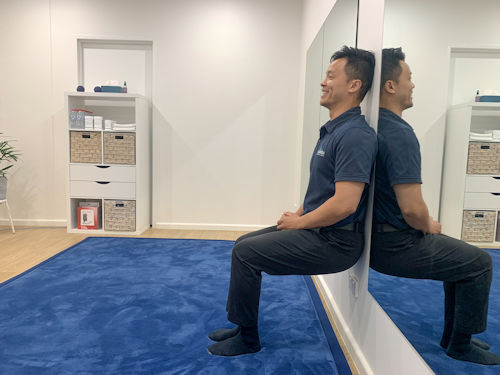In today’s fast-paced world, neck and back pain have become all too common complaints. Whether it’s hours spent hunched over a computer or the constant gaze down at our smartphones, poor posture is often the invisible culprit behind this discomfort. The issue is so prevalent that it’s easy to overlook, yet its impact on our well-being is far from trivial.
This article aims to shed light on the importance of maintaining good posture, not just to alleviate neck and back pain but to enhance your overall quality of life.
The Anatomy of Poor Posture
When we talk about poor posture, we’re often referring to a misalignment of the spine and surrounding muscles. But what does that really mean?
Imagine your spine as a column of building blocks. When these blocks are stacked neatly, they provide a stable foundation. However, when they’re misaligned, the entire structure becomes unstable. This is where the role of core stability and postural muscles comes into play.
Core stability is essentially the ability of your core muscles to stabilise your spine. These muscles include the rectus abdominis, the obliques, and the erector spinae, among others which are located around your torso. They work in tandem with your postural muscles, which are responsible for maintaining the alignment of your spine. When your core is weak or your postural muscles are imbalanced, it places undue stress on your spine, leading to poor posture.
In a state of poor posture, the natural curves of the spine are either exaggerated or diminished, causing a ripple effect of muscle imbalances throughout the body. For example, a slouched posture can lead to an exaggerated curve in the upper back, known as kyphosis, and a flattened lower back, or lumbar lordosis. These misalignments not only affect the spine but also have a cascading effect on the surrounding muscles, ligaments, and even organs.
Understanding the interplay between core stability and postural muscles is crucial because they impact each other. A strong core enhances postural alignment, while good posture, in turn, supports core stability. It’s a symbiotic relationship that serves as the foundation for not just a pain-free life but also for optimal health and well-being.

The Consequences of Putting Up With Poor Posture
Ignoring the signs of poor posture can lead to a host of long-term problems that go beyond mere discomfort. One of the most immediate consequences is chronic pain, particularly in the neck and back. This pain is not just a symptom but a warning sign that your body is out of alignment. Over time, poor posture can lead to inflammation, a natural response of the body to injury or stress. Inflammatory markers like cytokines increase, signalling the immune system to repair damaged tissues.
However, chronic inflammation can have a profound effect on posture. Inflammation is an immune response to injury, infection, or irritation, and when it becomes chronic, it can lead to changes in the body that impact posture in various ways:
- Muscle Tension: Inflammatory cytokines can lead to increased muscle tension and spasms, which may cause an individual to adopt compensatory postures that alleviate discomfort but ultimately lead to poor posture habits.
- Joint Stiffness: Chronic inflammation, particularly in conditions like arthritis, can cause stiffness in joints. This stiffness may limit the range of motion, leading individuals to adjust their posture to minimize pain, often at the expense of proper alignment.
- Pain: Persistent pain due to inflammation can cause a person to hunch, lean, or favour one side of the body. Over time, these adjustments can result in asymmetrical posture and can even lead to structural changes.
- Degradation of Connective Tissue: Chronic inflammation can break down collagen and other supportive structures in the connective tissues, leading to weakened areas that cannot support proper posture.
- Adaptive Shortening: When inflammation is present over a long period, muscles and tendons can shorten or adapt to new, often misaligned, postures. This can make returning to a correct posture difficult without intervention.
- Fatigue: Inflammation often leads to fatigue, which can cause slouching and a lack of energy to maintain proper posture.
Another significant issue is reduced blood flow. When your posture is poor, it can constrict blood vessels, leading to inadequate circulation. This is especially concerning for the delivery of essential nutrients and oxygen to various parts of the body. Reduced blood flow can exacerbate inflammation and contribute to the cycle of chronic pain.
In essence, poor posture sets off a chain reaction in the body. It starts with misalignment, leading to muscle imbalances, which then cause chronic pain, inflammation, and reduced blood flow. These issues can further escalate into more severe health problems if not addressed promptly.
How to Improve Posture: Practical Tips
Improving your posture is not just about standing up straight; it’s about creating a lifestyle that supports spinal health and overall well-being. Here are some actionable tips that can make a significant difference:
Daily Habits for Improved Posture: A Step-by-Step Guide
Improving your posture is a commitment that starts with incorporating mindful habits into your daily routine. Here’s a detailed, step-by-step guide to help you make posture-conscious choices throughout your day.
Step 1: Morning Alignment Check
- As soon as you wake up, stand against a wall with your heels, buttocks, and shoulder blades touching it. Try to press the back of your head against the wall without tilting it backward.
- This exercise helps you become aware of your natural spinal alignment and sets the tone for maintaining good posture throughout the day.
Step 2: Lunchtime Walk
- Take a short walk during your lunch break, keeping your shoulders back and your head level.
- Walking with good posture not only stretches out any kinks but also helps reinforce the habit of proper alignment.
Step 3: Evening Wind-Down
- Before going to bed, spend a few minutes doing some gentle exercises to relax your muscles (you can check these out below).
- Stretching can help relieve any tension built up during the day, making it easier to sleep with good posture (yes this is equally important), get a great night’s sleep and maintain focus on good posture the next day as well.
Exercises for Improved Posture: A Step-by-Step Guide
Incorporating specific exercises into your routine can significantly improve your posture and core stability. Here’s a detailed guide to help you strengthen your postural muscles effectively.
1: Plank
- Start in a push-up position but with your weight on your forearms instead of your hands. Keep your body in a straight line from head to heels and maintain this position- start with 30 seconds at a time and increase this as you improve.
- Planks are excellent for strengthening your core, which is essential for good posture.
2: Bridge
- Lie on your back with your knees bent and feet flat on the floor. Lift your hips towards the ceiling while keeping your feet and shoulders on the ground. Repeat 15 times and progressively increase this as you improve.
- This exercise targets the glutes and lower back, helping to correct posterior pelvic tilt and strengthen your core.
3: Wall Sits

- Stand with your back against a wall. Slide down until your thighs are parallel to the ground, keeping your back flat against the wall and maintain this position. Start with 30 seconds at a time and increase this as you improve.
- Wall sits are great for building endurance in your postural muscles.
4: Shoulder Blade Squeeze
- Sit or stand up straight. Squeeze your shoulder blades together as if you’re trying to hold a pencil between them and hold this squeeze, start with 30 seconds at a time and increase this as you improve.
- This exercise helps combat rounded shoulders, a common postural problem.
5: Chin Tucks
- Sit or stand up straight. Gently tuck your chin to your chest without bending your neck forward. Repeat 15 times and progressively increase this as you improve.
- Chin tucks can help correct forward head posture, relieving strain on the neck.
6: Chest Opener Stretch
- Stand with your arms extended to the sides. Gently pull your arms back, squeezing your shoulder blades together and hold this stretch, start with 30 seconds at a time and increase this as you improve.
- This stretch opens up the chest, counteracting the hunched posture that comes from sitting at a desk, driving, or simply scrolling on your phone repetitively.
7: Cat-Cow Stretch
- Start on all fours. Arch your back like a cat, then dip it down, lifting your head and tailbone towards the ceiling. Repeat 15 times and progressively increase this as you improve.
- This stretch is excellent for spinal flexibility, helping to correct any stiffness that contributes to poor posture.
By adding these exercises to your daily or weekly routine, you can build the muscle strength and flexibility needed for proper posture. These exercises are not just about looking better; they’re about creating a foundation for long-term health and well-being.
By incorporating these practical tips into your daily routine, you can maintain the benefits gained from professional treatments and create a sustainable path to better posture and less pain.
The Evolution Medical Care Approach
At Evolution Medical Care, we understand that each individual’s health journey is unique. That’s why we offer a range of science-backed treatments tailored to your specific needs. Our Remedial Massage focuses on relieving muscle tension and improving blood flow, while Trigger Point Therapy targets specific areas of tightness in the muscle fibres. Acupuncture, a treatment steeped in both tradition and modern science, aims to restore balance in the nervous system and reduce inflammation. Our Postural Alignment therapy is designed to correct imbalances in the spine and surrounding muscles, offering long-term relief from pain.

These treatments are not just stand-alone solutions but are often integrated into a comprehensive care plan. By combining these therapies, we aim to address the root cause of your posture issues, rather than just treating the symptoms.
The Benefits of Good Posture
The advantages of maintaining good posture extend far beyond alleviating neck and back pain!
When you stand or sit correctly, you’re doing more than just looking confident; you’re enhancing your overall health. This study showed that simply adopting a ‘good posture’ pose when stressed can help us feel more relaxed and otherwise, research shows that good posture has been linked to improved mental health, thanks in part to the balanced release of hormones like serotonin and dopamine. These neurotransmitters play a crucial role in mood regulation, and their optimal function is more likely when your body is well-aligned.
Moreover, studies show that a well-aligned spine allows for better digestion and respiratory health. The digestive and respiratory organs function more efficiently when they’re in their natural position, unencumbered by the compressive effects of poor posture. This can lead to improved nutrient absorption, overall digestive health and breathing proficiency.
Additionally, good posture supports a robust immune system. When your body is in alignment, it’s easier for the lymphatic system to function, which in turn helps your immune system operate at its best. This is another example of how posture impacts homeostasis, the body’s ability to maintain a stable internal environment.
In essence, good posture is a cornerstone of holistic well-being. It positively impacts various biochemical processes, from the balance of neurotransmitters to the maintenance of homeostasis, making it an essential aspect of a healthy lifestyle.
Ready to Get Started?
You’ve taken the first step by educating yourself on the importance of good posture and its far-reaching benefits. Now it’s time to take action!
At Evolution Medical Care, we’re committed to helping you achieve your health goals through personalised, science-backed treatments. Whether you’re dealing with chronic pain, looking to improve your posture, or seeking a comprehensive approach to better health, we’re here to guide you every step of the way.
Don’t let poor posture hold you back from living your best life. Book an appointment online or give us a call at (02) 4709 6727. We look forward to discussing how we can help you embark on a journey towards optimal health.






